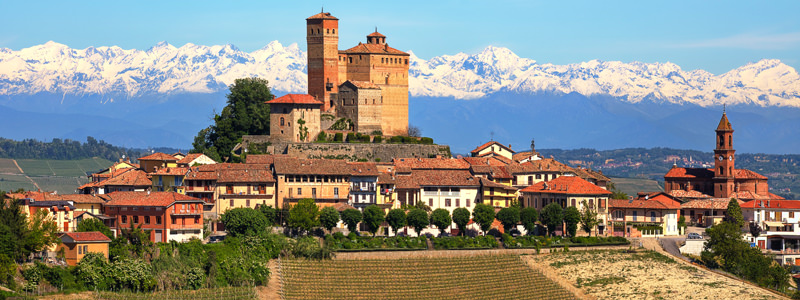In the northwest corner of Italy sits one of the most magical wine regions in the world that produces some of the world’s greatest wines. Piedmont is an Italian region like no other. Sharing its borders with both France and Switzerland, it is a picturesque region of mountains and valleys, overrun with vineyards, castles and incredible cuisine. Once the seat of the Savoy empire, since the nineteenth century, Piedmont has been known for its Barolo and Barbaresco, the wine of kings and queens, delicious crave-worthy wines made from the Nebbiolo grape that are amongst some of the most coveted wines in the world.
The influence of France, especially on the region’s wine and cuisine is obvious, which makes visiting the region an experience like none other. As you journey over the rolling hills from winery to winery, stopping at humble trattorias or a local farm stand for your food, you’ll often have to remind yourself that you’re actually in Italy and not that other region across the border in France famous for the wine it makes from Pinot Noir.
However, while Piedmont has always been on the radar as a destination for travelers and wine collectors, that doesn’t mean the region, or its wine, also shares the steep price tag of wine regions like Burgundy, you just have to know where to go.
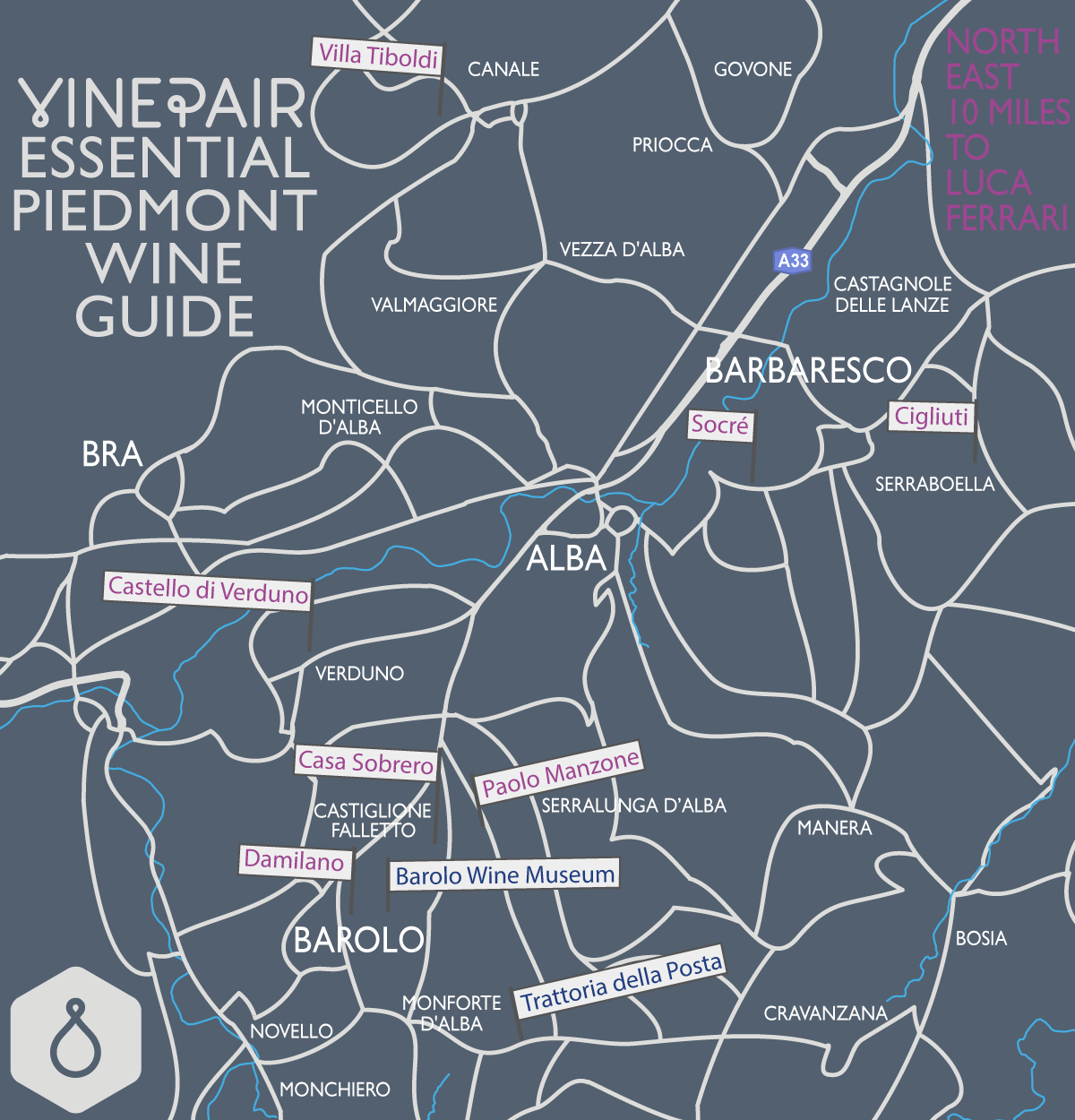
Getting to Piedmont from the rest of Italy is rather simple, as long as you’re willing to rent a car; besides, half the fun is driving around the winding hills as you bounce from winery to winery, making new discoveries along the way. We recommend taking the train to Turin, the largest city in Piedmont and easily accessible from Italy’s other main cities, or flying directly into Milan, which is just to the region’s east, and then renting your car in either metro area to drive into wine country.
First Stop, An Unexpected Wine
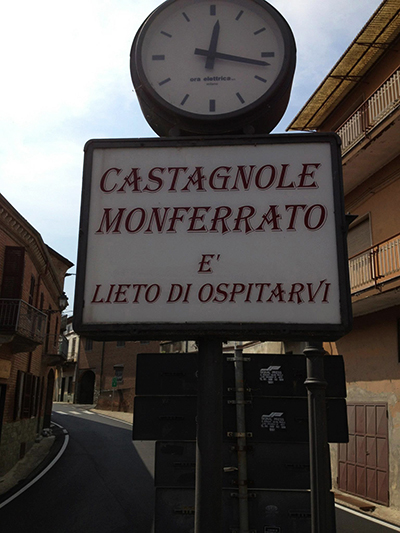 As you leave the metropolitan cities behind for the rolling hills of wine country, the first stop on your winery adventure won’t be for the Barolo and Barbaresco for which the region is known, but instead for the Ruché wine made by Luca Ferrari. While the region may be famous for Nebbiolo, only five communes in Piedmont can use that Nebbiolo to make Barolo and only three others can use it to make Barbaresco, which leaves a lot of land for other fantastic wines, Ruché being one of them.
As you leave the metropolitan cities behind for the rolling hills of wine country, the first stop on your winery adventure won’t be for the Barolo and Barbaresco for which the region is known, but instead for the Ruché wine made by Luca Ferrari. While the region may be famous for Nebbiolo, only five communes in Piedmont can use that Nebbiolo to make Barolo and only three others can use it to make Barbaresco, which leaves a lot of land for other fantastic wines, Ruché being one of them.
Ferrari inherited the winery from his father and immediately decided to begin experimenting with the lesser known native grapes of the region, creating wines from Barbera, Ruché and Grignolino. In his experimentations he traveled to the U.S. where he received mentorship from Randall Grahm, and Grahm’s passion for experimentation can be clearly seen on Ferrari’s wines as well. After tasting all Ferrari has to offer, consider a stop in the center of the small town Ferrari’s winery calls home, Castagnole Monferatto. There’s a quaint church, picturesque views and Restaurant Da Geppe, a humble place to have a delicious lunch and a few more glasses of wine.
Off To Barolo Country
From Castagnole Monferatto and Ferrari’s fantastic Ruché, head to the heart of Barolo country. This is the liquid gold you came for in the first place, so it makes the most sense to stay in this area of Piedmont as well. While you could stay in a hotel, if that’s your desire, Italy also has fabulous agriturismos that allow you to stay on a working farm or vineyard and some can even be quite high end.
One such high-end Agriturismo is Villa Tiboldi, while not the most centrally located, this winery and hotel is a fantastic place to stay, though we actually prefer going here for Tiboldi’s excellent restaurant instead of to sleep. The restaurant has a fifty euro traditional Piedmontese tasting menu which includes wine pairings, which for that price is a steal. You won’t find a better deal on such a high-end meal. It’s worth booking ahead and asking for a table on the edge of the hillside.
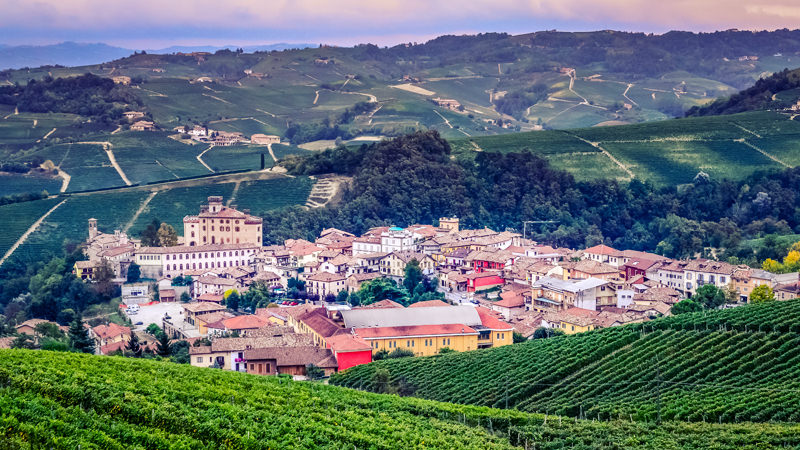
Our agriturismo of choice is a bit closer to the center of it all and is owned by winemaker Gian Paolo Manzone and his wife Luisella in the commune of Serralunga d’Alba. Manzone’s family has been in the wine business for six generations, and his Barolos are truly spectacular. While the digs aren’t as fancy as those you’ll find at Villa Tiboldi, it’s a real treat to stay with him and his wife on their vineyard, waking up each morning to the sound of a winery abuzz with work and going to sleep each night after helping yourself to another delicious bottle of his wine. Manzone’s wine has never received the international acclaim of some of the big name producers in the region, which is to your benefit, because this means you can score a case to take home at a very affordable price.
Should you choose to stay with Paolo and Luisella, make one of your dinner reservations down the road at Trattoria della Posta. It’s a place the Manzones dine at for special occasions, and it was during this dining experience that we learned from Luisella that wines from the area that are just labeled Nebbiolo instead of Barolo or Barbaresco are the Piedmontese little secret. She explained that there is great value in the Nebbiolo wines because they don’t have the Barolo label, and are thus much more affordable. She told us that it’s the wine they order at nice restaurants so they can drink a similar wine to Barolo, without paying the Barolo price tag.
From the Manzones’ vineyard you’re in the perfect position to check out two other fantastic Barolo producers that have also flown somewhat under the radar. You’ll just want to make sure you have enough room in your suitcase! The first winery you should visit is Sobrero, located close by Manzone in Castiglione Falletto. Established in 1940 by the grandparents of the current winemaker, Sobrero makes delicious Barolos, Barberas and Dolcettos. Be sure to grab a bottle of their Nebbiolo as well before you leave. It’s at a quality level equal to their Barolo, just without the fancy name.
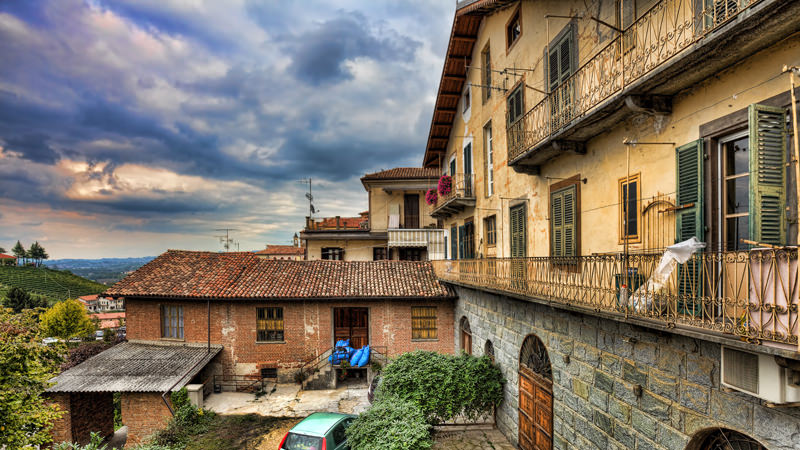
Following a visit to Sobrero, head to Castello Di Verduno, which is located in an old castle in the center of the commune of Verduno. When you arrive for your visit, ask to see the historic cellar located in the castle’s catacombs; they are definitely a unique site! Once down in the cellar you’ll find bottles going back to the 1800s, but unfortunately unless you come with thousands of dollars in your pockets, those probably won’t be included in your tasting. In addition to the winery, Castello also operates an agriturismo and a restaurant, making it an ideal place to stay and dine as well.
After paying a visit to these wineries, head to the town of Barolo to see how this incredible wine became such an international hit. While the town center can be a bit touristy, we love that there are so many little shops and sights to visit, including the Barolo Wine Museum. After a tour of the museum, which should take a few hours, feel free to pop in to the satellite tasting rooms of some of the regions bigger named Barolo producers which are also located in the town’s center. While these experiences will definitely feel more corporate than the wineries recommended above (and below), the wines are still fantastic and worth a taste if you’re in the mood.
Another winery that has become more corporate over the years, but only short drive from Barolo’s town center and worth a stop, is Damilano. While it’s best to call ahead and make arrangements to visit the other wineries we’ve mentioned, a visit to Damilano won’t take an appointment at all; just pop in and someone should be happy to give you a tour and tasting. The barrel room at Damilano is particularly impressive, so don’t miss it.
A Journey To The Wine Of Queens
After fully experiencing all that Barolo has to offer, it’s time for a visit to Barbaresco, to experience the more feminine side of the Nebbiolo grape. If you’re headed to Barbaresco from the Barolo area on a Tuesday or Saturday, first stop in the town of Alba and grab some food for the day at the outdoor farmers market. It’s located directly in the center square.
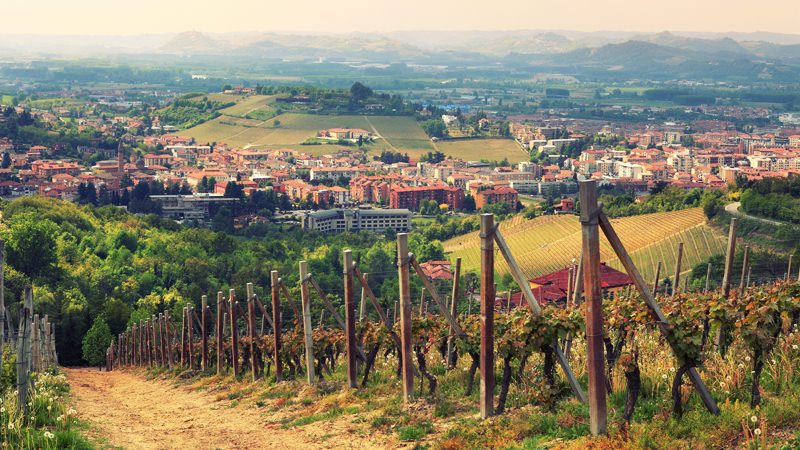
Once you’ve grabbed food and are finally on your way, you’re going to want to definitely try to visit two of our favorite Barbaresco wineries, but you’ll need to make arrangements ahead of time with both in order to stop by.
The first of the two is Cigliuti which is run by Renato Cigliuti and his two daughters, Claudia and Silvia, though at this point the daughters are really running the show. Claudia and Silvia each split duties in the winery with one overseeing the vineyard and the other overseeing the vinification process. Combined they create some of the best Barbaresco we have ever tasted. It is imperative that you leave with a few bottles. Also say hello to their vineyard dog; he’s a real sweetheart.
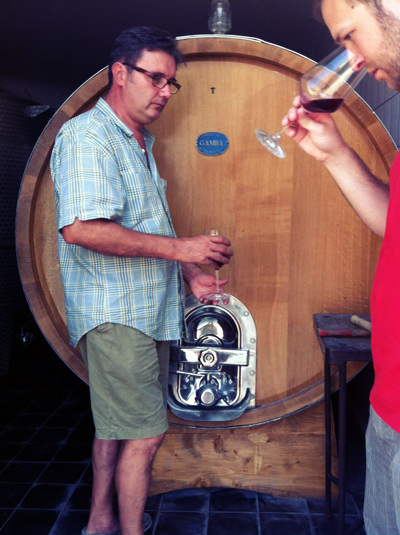
From Cigliutti doubleback to Socre where the winemaking is also a family affair. Marco Piacentino and his sons are all architects by training who had left the area for jobs in big Italian cities, but recently they have returned to the historic family land of Marco’s ancestors and discovered that they are quite good not only at designing buildings but also at making wine. It also doesn’t hurt that the land that was in Piacentino’s family shares a border with the most famous Barbaresco producer of all, Gaja.
Once you’re full on Socre’s wine and your trunk is more than likely full with bottles, before leaving the area, head a few miles down the road into the actual town of Barbaresco. Here, like in Barolo, you’ll find some shops and tasting rooms, but the site you’re really here for is The Tower of Barbaresco. Built in the year 1000, the tower is a pretty impressive site, and the town has built an observation deck that allows you to go to the top and take in the stunning views of the surrounding vineyards; it’s definitely worth a stop.
With suitcases filled with wine, and probably a camera out of memory, it’s time to head home. Just remember, you can legally bring back twelve bottles to the U.S. in your suitcase before you need to pay any fees!
Some images via Shutterstock.com

